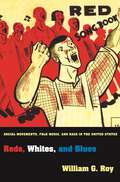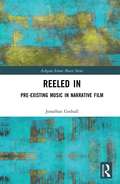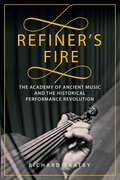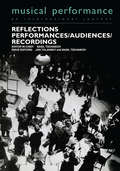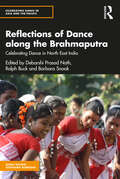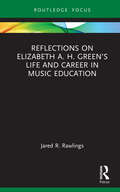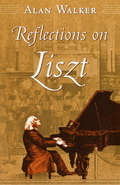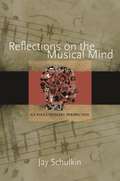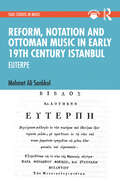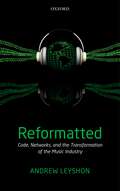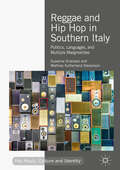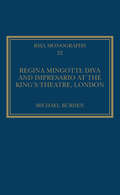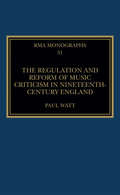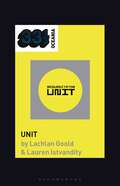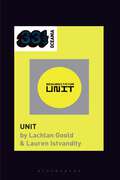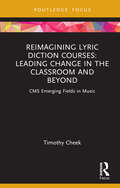- Table View
- List View
Reds, Whites, and Blues: Social Movements, Folk Music, and Race in the United States
by William G. RoyMusic, and folk music in particular, is often embraced as a form of political expression, a vehicle for bridging or reinforcing social boundaries, and a valuable tool for movements reconfiguring the social landscape. Reds, Whites, and Blues examines the political force of folk music, not through the meaning of its lyrics, but through the concrete social activities that make up movements. Drawing from rich archival material, William Roy shows that the People's Songs movement of the 1930s and 40s, and the Civil Rights Movement of the 1950s and 60s implemented folk music's social relationships--specifically between those who sang and those who listened--in different ways, achieving different outcomes. Roy explores how the People's Songsters envisioned uniting people in song, but made little headway beyond leftist activists. In contrast, the Civil Rights Movement successfully integrated music into collective action, and used music on the picket lines, at sit-ins, on freedom rides, and in jails. Roy considers how the movement's Freedom Songs never gained commercial success, yet contributed to the wider achievements of the Civil Rights struggle. Roy also traces the history of folk music, revealing the complex debates surrounding who or what qualified as "folk" and how the music's status as racially inclusive was not always a given. Examining folk music's galvanizing and unifying power, Reds, Whites, and Blues casts new light on the relationship between cultural forms and social activity.
Reds, Whites, and Blues: Social Movements, Folk Music, and Race in the United States
by William G. RoyMusic, and folk music in particular, is often embraced as a form of political expression, a vehicle for bridging or reinforcing social boundaries, and a valuable tool for movements reconfiguring the social landscape. Reds, Whites, and Blues examines the political force of folk music, not through the meaning of its lyrics, but through the concrete social activities that make up movements. Drawing from rich archival material, William Roy shows that the People's Songs movement of the 1930s and 40s, and the Civil Rights Movement of the 1950s and 60s implemented folk music's social relationships--specifically between those who sang and those who listened--in different ways, achieving different outcomes. Roy explores how the People's Songsters envisioned uniting people in song, but made little headway beyond leftist activists. In contrast, the Civil Rights Movement successfully integrated music into collective action, and used music on the picket lines, at sit-ins, on freedom rides, and in jails. Roy considers how the movement's Freedom Songs never gained commercial success, yet contributed to the wider achievements of the Civil Rights struggle. Roy also traces the history of folk music, revealing the complex debates surrounding who or what qualified as "folk" and how the music's status as racially inclusive was not always a given. Examining folk music's galvanizing and unifying power, Reds, Whites, and Blues casts new light on the relationship between cultural forms and social activity.
Reeled In: Pre-existing Music in Narrative Film (Ashgate Screen Music Series)
by Jonathan GodsallHow and why is pre-existing music used in films? What effects can its use have on films and their audiences? And what lasting impact can appropriation have on the music? Reeled In is a comprehensive exploration of these questions, considering the cinematic quotation of Beethoven symphonies, Beatles songs, and Herrmann scores alike in films ranging from the early sound era to the present day, and in every role from ‘main title theme’ to ‘music playing in bar’. Incorporating a discussion of such factors as copyright and commerce alongside examination of texts and their effects, this broad study is a significant contribution to the scholarship on music in screen media, demonstrating that pre-existing music possesses unique attributes that can affect both how filmmakers construct their works and how audiences receive them, to an extent regardless of the music’s style, genre, and so on. This book also situates the reception of music by film, and by audiences experiencing that music through film, as significant processes within present-day culture, while more generally providing an illuminating case study of the kinds of borrowings, adaptations, and reinventions that characterize much of today’s art and entertainment.
Reeled In: Pre-existing Music in Narrative Film (Ashgate Screen Music Series)
by Jonathan GodsallHow and why is pre-existing music used in films? What effects can its use have on films and their audiences? And what lasting impact can appropriation have on the music? Reeled In is a comprehensive exploration of these questions, considering the cinematic quotation of Beethoven symphonies, Beatles songs, and Herrmann scores alike in films ranging from the early sound era to the present day, and in every role from ‘main title theme’ to ‘music playing in bar’. Incorporating a discussion of such factors as copyright and commerce alongside examination of texts and their effects, this broad study is a significant contribution to the scholarship on music in screen media, demonstrating that pre-existing music possesses unique attributes that can affect both how filmmakers construct their works and how audiences receive them, to an extent regardless of the music’s style, genre, and so on. This book also situates the reception of music by film, and by audiences experiencing that music through film, as significant processes within present-day culture, while more generally providing an illuminating case study of the kinds of borrowings, adaptations, and reinventions that characterize much of today’s art and entertainment.
Refiner’s Fire: The Academy Of Ancient Music And The Historical Performance Revolution
by Richard BratbyReflections: Performers/Audiences/Recordings
by Basil Tschaikov Jon TolanskyFirst Published in 1997. Routledge is an imprint of Taylor & Francis, an informa company.
Reflections: Performers/Audiences/Recordings (Musical Performance Ser. #Vols. 1, Pts. 1.)
by Basil Tschaikov Jon TolanskyFirst Published in 1997. Routledge is an imprint of Taylor & Francis, an informa company.
Reflections of Dance along the Brahmaputra: Celebrating Dance in North East India (Celebrating Dance in Asia and the Pacific)
by Debarshi Prasad Nath, Ralph Buck, and Barbara SnookThis volume brings a critical lens to dance and culture within North East India. Through case studies, first-hand accounts, and interviews, it explores unique folk dances of Indigenous communities of North East India that reflect diverse journeys, lifestyles, and connections within their ethnic groups, marking almost every ritual and festival. Dance for people of North East India, as elsewhere, is also a way of declaring, establishing, celebrating, and asserting humans' relationship with nature. The book draws attention to the origins and special circumstances of dances from North East India. It discusses a range of important folk-dance forms alongside classical dance forms in North East India, with a focus on Sattriya dance. The chapters examine how these dance forms play an important role in the region’s socio-cultural, economic, and political life, intertwining religion and the arts through music, dance, and drama. Further, they also explore how folk dance cultures in North East India have never been relegated to the background, never considered secondary, aesthetically, or otherwise, but have become expressions of political and cultural identity. An evocative work, this volume will be of interest to students and researchers of pedagogy, choreography, community dance practice, theatre and performance studies, social and cultural studies, aesthetics, interdisciplinary arts, and more. It will be an invaluable resource for artists and practitioners working in dance schools and communities.
Reflections of Dance along the Brahmaputra: Celebrating Dance in North East India (Celebrating Dance in Asia and the Pacific)
This volume brings a critical lens to dance and culture within North East India. Through case studies, first-hand accounts, and interviews, it explores unique folk dances of Indigenous communities of North East India that reflect diverse journeys, lifestyles, and connections within their ethnic groups, marking almost every ritual and festival. Dance for people of North East India, as elsewhere, is also a way of declaring, establishing, celebrating, and asserting humans' relationship with nature. The book draws attention to the origins and special circumstances of dances from North East India. It discusses a range of important folk-dance forms alongside classical dance forms in North East India, with a focus on Sattriya dance. The chapters examine how these dance forms play an important role in the region’s socio-cultural, economic, and political life, intertwining religion and the arts through music, dance, and drama. Further, they also explore how folk dance cultures in North East India have never been relegated to the background, never considered secondary, aesthetically, or otherwise, but have become expressions of political and cultural identity. An evocative work, this volume will be of interest to students and researchers of pedagogy, choreography, community dance practice, theatre and performance studies, social and cultural studies, aesthetics, interdisciplinary arts, and more. It will be an invaluable resource for artists and practitioners working in dance schools and communities.
Reflections on Elizabeth A. H. Green’s Life and Career in Music Education
by Jared R. RawlingsAn engaging integration of scholarship and storytelling, Reflections on Elizabeth A. H. Green’s Life and Career in Music Education details the life and career of a pioneering figure in the field of instrumental music teacher education, who was one of the first to document a curriculum for teaching conducting and stringed instruments. Featuring interviews with Green’s former students, faculty colleagues, and close friends, this account combines reflections and memories with Green’s conducting techniques and teachings. Reflections on Elizabeth A. H. Green’s Life and Career in Music Education uncovers pedagogical insights not available in the late educator’s published texts, focusing on ways to assist instructors in new and different ways to manage and direct large ensembles and build confidence in undergraduate music majors. Through the exploration of an extraordinary educator’s life, it offers new insights into both the history of music education and present-day pedagogy for string instruments and conducting.
Reflections on Elizabeth A. H. Green’s Life and Career in Music Education
by Jared R. RawlingsAn engaging integration of scholarship and storytelling, Reflections on Elizabeth A. H. Green’s Life and Career in Music Education details the life and career of a pioneering figure in the field of instrumental music teacher education, who was one of the first to document a curriculum for teaching conducting and stringed instruments. Featuring interviews with Green’s former students, faculty colleagues, and close friends, this account combines reflections and memories with Green’s conducting techniques and teachings. Reflections on Elizabeth A. H. Green’s Life and Career in Music Education uncovers pedagogical insights not available in the late educator’s published texts, focusing on ways to assist instructors in new and different ways to manage and direct large ensembles and build confidence in undergraduate music majors. Through the exploration of an extraordinary educator’s life, it offers new insights into both the history of music education and present-day pedagogy for string instruments and conducting.
Reflections on Liszt
by Alan WalkerIn a series of lively essays that tell us much not only about the phenomenon that was Franz Liszt but also about the musical and cultural life of nineteenth-century Europe, Alan Walker muses on aspects of Liszt's life and work that he was unable to explore in his acclaimed three-volume biography of the great composer and pianist. Topics include Liszt's contributions to the Lied, the lifelong impact of his encounter with Beethoven, his influence on students who became famous in their own right, his accomplishments in transcribing and editing the works of other composers, and his innovative piano technique. One chapter is devoted to the Sonata in B Minor, perhaps Liszt's single most celebrated composition.Walker draws heavily on Liszt's astonishingly large personal correspondence with other composers, critics, pianists, and prominent public figures. All the essays reveal Walker's broad and deep knowledge of Liszt and Romantic music generally and, in some cases, his impatience with contemporary performance practice.
Reflections on the Musical Mind: An Evolutionary Perspective
by Jay Schulkin Robert O. GjerdingenWhat's so special about music? We experience it internally, yet at the same time it is highly social. Music engages our cognitive/affective and sensory systems. We use music to communicate with one another--and even with other species--the things that we cannot express through language. Music is both ancient and ever evolving. Without music, our world is missing something essential.In Reflections on the Musical Mind, Jay Schulkin offers a social and behavioral neuroscientific explanation of why music matters. His aim is not to provide a grand, unifying theory. Instead, the book guides the reader through the relevant scientific evidence that links neuroscience, music, and meaning. Schulkin considers how music evolved in humans and birds, how music is experienced in relation to aesthetics and mathematics, the role of memory in musical expression, the role of music in child and social development, and the embodied experience of music through dance. He concludes with reflections on music and well-being. Reflections on the Musical Mind is a unique and valuable tour through the current research on the neuroscience of music.
Reflections on the Musical Mind: An Evolutionary Perspective
by Jay Schulkin Robert O. GjerdingenWhat's so special about music? We experience it internally, yet at the same time it is highly social. Music engages our cognitive/affective and sensory systems. We use music to communicate with one another--and even with other species--the things that we cannot express through language. Music is both ancient and ever evolving. Without music, our world is missing something essential.In Reflections on the Musical Mind, Jay Schulkin offers a social and behavioral neuroscientific explanation of why music matters. His aim is not to provide a grand, unifying theory. Instead, the book guides the reader through the relevant scientific evidence that links neuroscience, music, and meaning. Schulkin considers how music evolved in humans and birds, how music is experienced in relation to aesthetics and mathematics, the role of memory in musical expression, the role of music in child and social development, and the embodied experience of music through dance. He concludes with reflections on music and well-being. Reflections on the Musical Mind is a unique and valuable tour through the current research on the neuroscience of music.
Reform, Notation and Ottoman music in Early 19th Century Istanbul: EUTERPE (SOAS Studies in Music)
by Mehmet Ali SanlıkolReform, Notation and Ottoman Music in Early 19th Century Istanbul: EUTERPE presents the first complete set of transcription and edition of Euterpe (1830) from Byzantine neumatic notation into the modified staff notation used by classical Turkish music and is accompanied by a substantial examination of the related historical, theoretical and musical topics. Through a series of Ottoman/Turkish classical vocal music compositions that can be dated to the 18th and 19th centuries, Euterpe and related sources reinforce a much broader picture of musical practice and transmission in which we clearly see that the Greek and Turkish traditions are linked. Reform, Notation and Ottoman Music in Early 19th Century Istanbul is presented in two parts: historical discussion and musical analysis, and complete transcription and edition of Euterpe. This book will appeal to music scholars and university students interested in minorities, cosmopolitanism in the Middle East and Balkans, the relationship between music and national identity, musical notation, classical Ottoman/Turkish music, Byzantine music, and, most significantly, ethnomusicology.
Reformatted: Code, Networks, And The Transformation Of The Music Industry
by Andrew LeyshonThe impact of digital technology on the musical economy has been profound. From its production, reproduction, distribution, and consumption, the advent of MP3 and the use of the Internet as a medium of distribution has brought about a significant transformation in the way that music is made, how it is purchased and listened to, and, significantly, how the musical economy itself is able to reproduce itself. In the late 1990s the obscure practice of 'ripping' tracks from CDs through the use of compression programmes was transformed from the illegal hobby of a few thousand computer specialists to a practice available to millions of people worldwide through the development of peer-to-peer computer networks. This continues to have important implications for the viability of the musical economy. At the same time, the production of music has become more accessible and the role of key gatekeepers in the industry—such as record companies and recording studios— has been undermined, whilst the increased accessibility of music at reduced cost via the Internet has revalorised live performance, and now generates revenues higher than recorded music. The early 21st century has provided an extraordinary case study of an industry in flux, and one that throws light on the relationship between culture and economy, between passion and calculation. This book provides a theoretically grounded account of the implications of digital technology on the musical economy, and develops the concept of the musical network to understand the transformation of this economy over space and through time.
Reggae and Hip Hop in Southern Italy: Politics, Languages, and Multiple Marginalities (Pop Music, Culture and Identity)
by Susanna Scarparo Mathias Sutherland StevensonThis book explores the significance of reggae and hip hop in Southern Italy from the beginning of the 1980s to the present. Focusing on groups and solo artists located predominantly in the Southern Italian regions of Apulia and Sardinia, it examines the production and distribution of their music, lyrics and video clips. To this end, Reggae and Hip Hop in Southern Italy emphasizes the linguistic aspects of cultural marginalization as well as marginalities linked to geographical location, gender, and to social and political identification. The authors put forward three key arguments, namely: that the Southern Italian transcultural and multilingual musical productions defy the cultural stereotype of the South; that the musicians discussed are creating new alliances and transcultural exchanges that engage critically with the challenges and opportunities offered by globalization; and that these musical productions represent one of Italy’s most significant forms of creative political expression since the 1970s. Reggae and Hip Hop in Southern Italy brings to light the distinctive characteristics of Italy’s independent and marginal musical contexts of reggae and reggae-inflected hip hop. It will serve as an invaluable resource for academics and students of Italian cultural studies, global studies, and the politics of non-hegemonic cultural production. It also provides an engaging reference for those with an interest in southern Italy, Apulia, Sardinia, the southern question and independent and popular music more generally.
Regina Mingotti: Diva and Impresario at the King's Theatre, London (Royal Musical Association Monographs)
by Michael BurdenRegina Mingotti was the first female impresario to run London's opera house. Born in Naples in 1722, she was the daughter of an Austrian diplomat, and had worked at Dresden under Hasse from 1747. Mingotti left Germany in 1752, and travelled to Madrid to sing at the Spanish court, where the opera was directed by the great castrato, Farinelli. It is not known quite how Francesco Vanneschi, the opera promoter, came to hire Mingotti, but in 1754 (travelling to England via Paris), she was announced as being engaged for the opera in London 'having been admired at Naples and other parts of Italy, by all the Connoisseurs, as much for the elegance of her voice as that of her features'. Michael Burden offers the first considered survey of Mingotti‘s London years, including material on Mingotti's publication activities, and the identification of the characters in the key satirical print 'The Idol'. Burden makes a significant contribution to the knowledge and understanding of eighteenth-century singers' careers and status, and discusses the management, the finance, the choice of repertory, and the pasticcio practice at The King's Theatre, Haymarket during the middle of the eighteenth century. Burden also argues that Mingotti‘s years with Farinelli influenced her understanding of drama, fed her appreciation of Metastasio, and were partly responsible for London labelling her a 'female Garrick'. The book includes the important publication of the complete texts of both of Mingotti's Appeals to the Publick, accounts of the squabble between Mingotti and Vanneschi, which shed light on the role a singer could play in the replacement of arias.
Regina Mingotti: Diva and Impresario at the King's Theatre, London
by Michael BurdenRegina Mingotti was the first female impresario to run London's opera house. Born in Naples in 1722, she was the daughter of an Austrian diplomat, and had worked at Dresden under Hasse from 1747. Mingotti left Germany in 1752, and travelled to Madrid to sing at the Spanish court, where the opera was directed by the great castrato, Farinelli. It is not known quite how Francesco Vanneschi, the opera promoter, came to hire Mingotti, but in 1754 (travelling to England via Paris), she was announced as being engaged for the opera in London 'having been admired at Naples and other parts of Italy, by all the Connoisseurs, as much for the elegance of her voice as that of her features'. Michael Burden offers the first considered survey of Mingotti‘s London years, including material on Mingotti's publication activities, and the identification of the characters in the key satirical print 'The Idol'. Burden makes a significant contribution to the knowledge and understanding of eighteenth-century singers' careers and status, and discusses the management, the finance, the choice of repertory, and the pasticcio practice at The King's Theatre, Haymarket during the middle of the eighteenth century. Burden also argues that Mingotti‘s years with Farinelli influenced her understanding of drama, fed her appreciation of Metastasio, and were partly responsible for London labelling her a 'female Garrick'. The book includes the important publication of the complete texts of both of Mingotti's Appeals to the Publick, accounts of the squabble between Mingotti and Vanneschi, which shed light on the role a singer could play in the replacement of arias.
The Regulation and Reform of Music Criticism in Nineteenth-Century England (Royal Musical Association Monographs)
by Paul WattMusic criticism in England underwent profound change from the 1880s to the 1920s. It gave rise to ‘New criticism’ that aimed to be rational, impartial and intellectually authoritative. It was a break from the criticism of old: the work of the opinionated journalist who wrote descriptive concert reviews with invective, cliché, bias and bombast. Critics such as Ernest Newman (1868–1959), John F. Runciman (1866–1916) and Michel D. Calvocoressi (1877–1944) fostered this new school and wrote extensively of their aspirations for musical criticism in their own times and for the future. This book charts the genesis of this new wave of musical criticism that sought to regulate and reform the profession of music critic. Alongside the establishment of principles, training manuals and schools for critics, hundreds of journal articles and dozens of books were written that encouraged new criticism, which also had a bearing on scholarly writing in biography, aesthetics and history. The Regulation and Reform of Music Criticism in Nineteenth-Century England considers the influence and advocacy of individual critics and the role that institutions, such as the Musical Association and the Musical Times, played in this period of change. The book also explores the impact that French and German writers had on their English counterparts, demonstrating the internationalization of critical thought of the period.
The Regulation and Reform of Music Criticism in Nineteenth-Century England (Royal Musical Association Monographs)
by Paul WattMusic criticism in England underwent profound change from the 1880s to the 1920s. It gave rise to ‘New criticism’ that aimed to be rational, impartial and intellectually authoritative. It was a break from the criticism of old: the work of the opinionated journalist who wrote descriptive concert reviews with invective, cliché, bias and bombast. Critics such as Ernest Newman (1868–1959), John F. Runciman (1866–1916) and Michel D. Calvocoressi (1877–1944) fostered this new school and wrote extensively of their aspirations for musical criticism in their own times and for the future. This book charts the genesis of this new wave of musical criticism that sought to regulate and reform the profession of music critic. Alongside the establishment of principles, training manuals and schools for critics, hundreds of journal articles and dozens of books were written that encouraged new criticism, which also had a bearing on scholarly writing in biography, aesthetics and history. The Regulation and Reform of Music Criticism in Nineteenth-Century England considers the influence and advocacy of individual critics and the role that institutions, such as the Musical Association and the Musical Times, played in this period of change. The book also explores the impact that French and German writers had on their English counterparts, demonstrating the internationalization of critical thought of the period.
Regurgitator's Unit (33 1/3 Oceania)
by Lachlan Goold Lauren IstvandityRegurgitator's second full-length album, Unit (1997), was produced in a DIY warehouse studio at a time when this was unusual for a major label band. The album went three times Platinum in Australia and won five esteemed ARIA Awards in 1998, including Album of the Year. The album's success is indicative of a particular point in time in popular music trends, when the world was recovering from the impact of grunge and post-grunge bands. Regurgitator's subversive attitude toward pop music, punk aesthetic, unique lyrical narratives and an ironic view on their own creative product made their music potent in an alternative market defying the prevailing music trends. Unit and Regurgitator were the focus of divisive critical reviews, yet they continue to rank highly as a quintessentially Australian band. This volume situates the development of Unit amongst the DIY culture of a politically charged Brisbane scene, and breaks down the album through the lens of recording and songwriting processes. This book outlines the impact of Regurgitator's music locally and globally, by discussing what made Unit a success at the peak of the alternative music genre.
Regurgitator's Unit (33 1/3 Oceania)
by Lachlan Goold Lauren IstvandityRegurgitator's second full-length album, Unit (1997), was produced in a DIY warehouse studio at a time when this was unusual for a major label band. The album went three times Platinum in Australia and won five esteemed ARIA Awards in 1998, including Album of the Year. The album's success is indicative of a particular point in time in popular music trends, when the world was recovering from the impact of grunge and post-grunge bands. Regurgitator's subversive attitude toward pop music, punk aesthetic, unique lyrical narratives and an ironic view on their own creative product made their music potent in an alternative market defying the prevailing music trends. Unit and Regurgitator were the focus of divisive critical reviews, yet they continue to rank highly as a quintessentially Australian band. This volume situates the development of Unit amongst the DIY culture of a politically charged Brisbane scene, and breaks down the album through the lens of recording and songwriting processes. This book outlines the impact of Regurgitator's music locally and globally, by discussing what made Unit a success at the peak of the alternative music genre.
Reimagining Lyric Diction Courses: CMS Emerging Fields in Music (CMS Emerging Fields in Music)
by Timothy CheekDrawing on 30 years of teaching experience, author Timothy Cheek demonstrates how a university lyric diction class—traditionally specialized and Eurocentric—can become transformative, through engaging students with other languages and cultures, and promoting diversity, equity, inclusivity, and antiracism. Raising new possibilities for traditional lyric diction pedagogy, this book explores how to provide students with experiences that speed their growth, help them to see the big picture, spark their curiosity, clarify and expand their digital resources and skills, and set them on a path of international collaboration. Arguing against compartmentalization in voice curricula, and exploring opportunities for creativity, the author provides a guide to new approaches that will aid schools’ decisions about diction curricula in the challenging but promising era of 21st-century pedagogy. Voice faculty, diction instructors, curriculum committees, graduate students in related fields, and music school administrators should all find this book insightful and thought-provoking as it goes to the heart of issues critical to the long-term development of today’s voice students.
Reimagining Lyric Diction Courses: CMS Emerging Fields in Music (CMS Emerging Fields in Music)
by Timothy CheekDrawing on 30 years of teaching experience, author Timothy Cheek demonstrates how a university lyric diction class—traditionally specialized and Eurocentric—can become transformative, through engaging students with other languages and cultures, and promoting diversity, equity, inclusivity, and antiracism. Raising new possibilities for traditional lyric diction pedagogy, this book explores how to provide students with experiences that speed their growth, help them to see the big picture, spark their curiosity, clarify and expand their digital resources and skills, and set them on a path of international collaboration. Arguing against compartmentalization in voice curricula, and exploring opportunities for creativity, the author provides a guide to new approaches that will aid schools’ decisions about diction curricula in the challenging but promising era of 21st-century pedagogy. Voice faculty, diction instructors, curriculum committees, graduate students in related fields, and music school administrators should all find this book insightful and thought-provoking as it goes to the heart of issues critical to the long-term development of today’s voice students.
